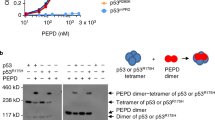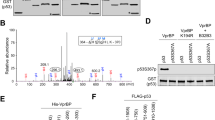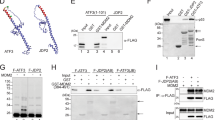Abstract
The p53 tumor suppressor interacts with its negative regulator Mdm2 via the former's N-terminal region and core domain, yet the extreme p53 C-terminal region contains lysine residues ubiquitinated by Mdm2 and can bear post-translational modifications that inhibit Mdm2-p53 association. We show that the Mdm2-p53 interaction is decreased upon deletion, mutation or acetylation of the p53 C terminus. Mdm2 decreases the association of full-length but not C-terminally deleted p53 with a DNA target sequence in vitro and in cells. Further, using multiple approaches, we show that a peptide from the p53 C terminus directly binds the Mdm2 N terminus in vitro. We also show that p300-acetylated p53 inefficiently binds Mdm2 in vitro, and Nutlin-3 treatment induces C-terminal modification(s) of p53 in cells, explaining the low efficiency of Nutlin-3 in dissociating p53-MDM2 in vitro.
This is a preview of subscription content, access via your institution
Access options
Subscribe to this journal
Receive 12 print issues and online access
$189.00 per year
only $15.75 per issue
Buy this article
- Purchase on Springer Link
- Instant access to full article PDF
Prices may be subject to local taxes which are calculated during checkout







Similar content being viewed by others
Change history
25 July 2010
In the version of this article initially published online, the Acknowledgments section was incomplete. The error has been corrected for the print, PDF and HTML versions of this article.
21 September 2010
In the version of this article initially published, the error bars in figures 1, 2, 4 and 5 were not defined, and a formatting mistake occurred in Supplementary Figure 1a. The errors have been corrected in the PDF and HTML versions of this article.
References
Vousden, K.H. & Prives, C. Blinded by the light: the growing complexity of p53. Cell 137, 413–431 (2009).
Barak, Y., Gottlieb, E., Juven-Gershon, T. & Oren, M. Regulation of mdm2 expression by p53: alternative promoters produce transcripts with nonidentical translation potential. Genes Dev. 8, 1739–1749 (1994).
Haupt, Y., Maya, R., Kazaz, A. & Oren, M. Mdm2 promotes the rapid degradation of p53. Nature 387, 296–299 (1997).
Lin, J., Chen, J., Elenbaas, B. & Levine, A.J. Several hydrophobic amino acids in the p53 amino-terminal domain are required for transcriptional activation, binding to mdm-2 and the adenovirus 5 E1B 55-kD protein. Genes Dev. 8, 1235–1246 (1994).
Kussie, P.H. et al. Structure of the MDM2 oncoprotein bound to the p53 tumor suppressor transactivation domain. Science 274, 948–953 (1996).
Vassilev, L.T. et al. In vivo activation of the p53 pathway by small-molecule antagonists of MDM2. Science 303, 844–848 (2004).
Klein, C. & Vassilev, L.T. Targeting the p53–MDM2 interaction to treat cancer. Br. J. Cancer 91, 1415–1419 (2004).
Issaeva, N. et al. Small molecule RITA binds to p53, blocks p53-HDM-2 interaction and activates p53 function in tumors. Nat. Med. 10, 1321–1328 (2004).
Shieh, S.Y., Ikeda, M., Taya, Y. & Prives, C. DNA damage-induced phosphorylation of p53 alleviates inhibition by MDM2. Cell 91, 325–334 (1997).
Appella, E. & Anderson, C.W. Signaling to p53: breaking the posttranslational modification code. Pathol. Biol. (Paris) 48, 227–245 (2000).
Kane, S.A. et al. Development of a binding assay for p53/HDM2 by using homogeneous time-resolved fluorescence. Anal. Biochem. 278, 29–38 (2000).
Sakaguchi, K. et al. Damage-mediated phosphorylation of human p53 threonine 18 through a cascade mediated by a casein 1-like kinase. Effect on Mdm2 binding. J. Biol. Chem. 275, 9278–9283 (2000).
Lai, Z., Auger, K.R., Manubay, C.M. & Copeland, R.A. Thermodynamics of p53 binding to hdm2(1–126): effects of phosphorylation and p53 peptide length. Arch. Biochem. Biophys. 381, 278–284 (2000).
Shimizu, H. et al. The conformationally flexible S9–S10 linker region in the core domain of p53 contains a novel MDM2 binding site whose mutation increases ubiquitination of p53 in vivo. J. Biol. Chem. 277, 28446–28458 (2002).
Wallace, M., Worrall, E., Pettersson, S., Hupp, T.R. & Ball, K.L. Dual-site regulation of MDM2 E3-ubiquitin ligase activity. Mol. Cell 23, 251–263 (2006).
Yu, G.W. et al. The central region of HDM2 provides a second binding site for p53. Proc. Natl. Acad. Sci. USA 103, 1227–1232 (2006).
Ma, J. et al. A second p53 binding site in the central domain of Mdm2 is essential for p53 ubiquitination. Biochemistry 45, 9238–9245 (2006).
Rodriguez, M.S., Desterro, J.M., Lain, S., Lane, D.P. & Hay, R.T. Multiple C-terminal lysine residues target p53 for ubiquitin-proteasome-mediated degradation. Mol. Cell. Biol. 20, 8458–8467 (2000).
Carter, S. & Vousden, K.H. Modifications of p53: competing for the lysines. Curr. Opin. Genet. Dev. 19, 18–24 (2009).
Carter, S., Bischof, O., Dejean, A. & Vousden, K.H. C-terminal modifications regulate MDM2 dissociation and nuclear export of p53. Nat. Cell Biol. 9, 428–435 (2007).
Li, M. et al. Mono- versus polyubiquitination: differential control of p53 fate by Mdm2. Science 302, 1972–1975 (2003).
Tang, Y., Zhao, W., Chen, Y., Zhao, Y. & Gu, W. Acetylation is indispensable for p53 activation. Cell 133, 612–626 (2008).
Le Cam, L. et al. E4F1 is an atypical ubiquitin ligase that modulates p53 effector functions independently of degradation. Cell 127, 775–788 (2006).
Hainaut, P. et al. IARC Database of p53 gene mutations in human tumors and cell lines: updated compilation, revised formats and new visualisation tools. Nucleic Acids Res. 26, 205–213 (1998).
Cho, Y., Gorina, S., Jeffrey, P.D. & Pavletich, N.P. Crystal structure of a p53 tumor suppressor-DNA complex: understanding tumorigenic mutations. Science 265, 346–355 (1994).
Sutherland, B.W., Toews, J. & Kast, J. Utility of formaldehyde cross-linking and mass spectrometry in the study of protein-protein interactions. J. Mass Spectrom. 43, 699–715 (2008).
Ahn, J. & Prives, C. The C-terminus of p53: the more you learn the less you know. Nat. Struct. Biol. 8, 730–732 (2001).
Cain, C., Miller, S., Ahn, J. & Prives, C. The N terminus of p53 regulates its dissociation from DNA. J. Biol. Chem. 275, 39944–39953 (2000).
Poyurovsky, M.V. et al. The Mdm2 RING domain C-terminus is required for supramolecular assembly and ubiquitin ligase activity. EMBO J. 26, 90–101 (2007).
McKinney, K., Mattia, M., Gottifredi, V. & Prives, C. p53 linear diffusion along DNA requires its C terminus. Mol. Cell 16, 413–424 (2004).
Schon, O., Friedler, A., Bycroft, M., Freund, S.M. & Fersht, A.R. Molecular mechanism of the interaction between MDM2 and p53. J. Mol. Biol. 323, 491–501 (2002).
Showalter, S.A., Bruschweiler-Li, L., Johnson, E., Zhang, F. & Bruschweiler, R. Quantitative lid dynamics of MDM2 reveals differential ligand binding modes of the p53-binding cleft. J. Am. Chem. Soc. 130, 6472–6478 (2008).
Ding, K. et al. Structure-based design of potent non-peptide MDM2 inhibitors. J. Am. Chem. Soc. 127, 10130–10131 (2005).
Garcia-Echeverria, C., Chene, P., Blommers, M.J. & Furet, P. Discovery of potent antagonists of the interaction between human double minute 2 and tumor suppressor p53. J. Med. Chem. 43, 3205–3208 (2000).
Duncan, S.J., Cooper, M.A. & Williams, D.H. Binding of an inhibitor of the p53/MDM2 interaction to MDM2. Chem. Commun. (Camb.) 316–317 (2003).
Bottger, V. et al. Identification of novel mdm2 binding peptides by phage display. Oncogene 13, 2141–2147 (1996).
Vassilev, L.T. Small-molecule antagonists of p53–MDM2 binding: research tools and potential therapeutics. Cell Cycle 3, 419–421 (2004).
Thompson, T. et al. Phosphorylation of p53 on key serines is dispensable for transcriptional activation and apoptosis. J. Biol. Chem. 279, 53015–53022 (2004).
Ohkubo, S., Tanaka, T., Taya, Y., Kitazato, K. & Prives, C. Excess HDM2 impacts cell cycle and apoptosis and has a selective effect on p53-dependent transcription. J. Biol. Chem. 281, 16943–16950 (2006).
de Stanchina, E. et al. E1A signaling to p53 involves the p19(ARF) tumor suppressor. Genes Dev. 12, 2434–2442 (1998).
Stott, F.J. et al. The alternative product from the human CDKN2A locus, p14(ARF), participates in a regulatory feedback loop with p53 and MDM2. EMBO J. 17, 5001–5014 (1998).
Hay, T.J. & Meek, D.W. Multiple sites of in vivo phosphorylation in the MDM2 oncoprotein cluster within two important functional domains. FEBS Lett. 478, 183–186 (2000).
Blattner, C., Hay, T., Meek, D.W. & Lane, D.P. Hypophosphorylation of Mdm2 augments p53 stability. Mol. Cell. Biol. 22, 6170–6182 (2002).
McCoy, M.A., Gesell, J.J., Senior, M.M. & Wyss, D.F. Flexible lid to the p53-binding domain of human Mdm2: implications for p53 regulation. Proc. Natl. Acad. Sci. USA 100, 1645–1648 (2003).
Ito, A. et al. p300/CBP-mediated p53 acetylation is commonly induced by p53-activating agents and inhibited by MDM2. EMBO J. 20, 1331–1340 (2001).
Kobet, E., Zeng, X., Zhu, Y., Keller, D. & Lu, H. MDM2 inhibits p300-mediated p53 acetylation and activation by forming a ternary complex with the two proteins. Proc. Natl. Acad. Sci. USA 97, 12547–12552 (2000).
Wahl, G.M. Mouse bites dogma: how mouse models are changing our views of how P53 is regulated in vivo. Cell Death Differ. 13, 973–983 (2006).
Feng, H. et al. Structural basis for p300 Taz2-p53 TAD1 binding and modulation by phosphorylation. Structure 17, 202–210 (2009).
Jenkins, L.M. et al. Two distinct motifs within the p53 transactivation domain bind to the Taz2 domain of p300 and are differentially affected by phosphorylation. Biochemistry 48, 1244–1255 (2009).
Gorgoulis, V.G. et al. Activation of the DNA damage checkpoint and genomic instability in human precancerous lesions. Nature 434, 907–913 (2005).
Bartkova, J. et al. DNA damage response as a candidate anti-cancer barrier in early human tumorigenesis. Nature 434, 864–870 (2005).
Lokshin, M., Li, Y., Gaiddon, C. & Prives, C. p53 and p73 display common and distinct requirements for sequence specific binding to DNA. Nucleic Acids Res. 35, 340–352 (2007).
Zhang, T. & Prives, C. Cyclin a-CDK phosphorylation regulates MDM2 protein interactions. J. Biol. Chem. 276, 29702–29710 (2001).
Rotem, S. et al. The structure and interactions of the proline-rich domain of ASPP2. J. Biol. Chem. 283, 18990–18999 (2008).
Cardinale, C.J. et al. Termination factor Rho and its cofactors NusA and NusG silence foreign DNA in E. coli. Science 320, 935–938 (2008).
Beckerman, R. et al. A role for Chk1 in blocking transcriptional elongation of p21 RNA during the S-phase checkpoint. Genes Dev. 23, 1364–1377 (2009).
Acknowledgements
We are exceedingly grateful to E. Freulich for her expert technical assistance and members of the Prives laboratory for their helpful suggestions. This work was supported by grant CA58316 from the US National Institutes of Health to C.P. A.F. is supported by a starting grant from the European Research Council under the European Community's Seventh Framework Programme (FP7/2007-2013) / ERC Grant agreement n° 203413.
Author information
Authors and Affiliations
Contributions
M.V.P., A.F. and C.P. designed research; M.V.P., C.K., O.L., M.L., J.A., I.-J.L.B., R.G., M.M., A.Z. and L.M.B. performed research and analyzed data; M.V.P. and C.P. wrote the manuscript.
Corresponding author
Ethics declarations
Competing interests
The authors declare no competing financial interests.
Supplementary information
Supplementary Text and Figures
Supplementary Figures 1–8 and Supplementary Methods (PDF 3837 kb)
Rights and permissions
About this article
Cite this article
Poyurovsky, M., Katz, C., Laptenko, O. et al. The C terminus of p53 binds the N-terminal domain of MDM2. Nat Struct Mol Biol 17, 982–989 (2010). https://doi.org/10.1038/nsmb.1872
Received:
Accepted:
Published:
Issue Date:
DOI: https://doi.org/10.1038/nsmb.1872
This article is cited by
-
Malic enzyme 2 maintains protein stability of mutant p53 through 2-hydroxyglutarate
Nature Metabolism (2022)
-
A link between mitotic defects and mitotic catastrophe: detection and cell fate
Biology Direct (2021)
-
Loss of TRIM31 promotes breast cancer progression through regulating K48- and K63-linked ubiquitination of p53
Cell Death & Disease (2021)
-
Towards reconstructing the dipteran demise of an ancient essential gene: E3 ubiquitin ligase Murine double minute
Development Genes and Evolution (2020)
-
A novel regulatory circuit between p53 and GFI1 controls induction of apoptosis in T cells
Scientific Reports (2019)



